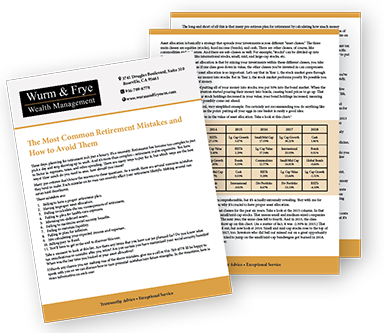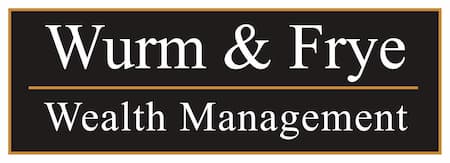
Avoid These Five Retirement Mistakes
Making retirement planning errors at any time, but especially when there’s economic uncertainty and market volatility, can create difficulties in achieving your long-term goals. Here are five common, and potentially costly, mistakes you’ll want to avoid
It all comes down to risk.
1. Getting out of the market after a downturn. When the market takes a big hit, you may be tempted to sell investments in your retirement portfolio and hold the proceeds in cash. If you do, you’ll may miss the gains if the market suddenly turns around.
Consider taking a long-term approach by keeping a strategic mix of asset classes in your portfolio: stocks, bonds, and cash alternatives. The combination that’s right for you will depend on a variety of factors, including how comfortable you are with market volatility (risk tolerance), what you’re investing for (objectives), and how long before you’ll need to tap into your accounts (time horizon).
And think about periodically rebalancing by checking your accounts to see if market activity has shifted your investments away from your desired asset allocation. If it has, you may want to buy and sell investments to bring your accounts back into alignment.
2. Not taking full advantage of retirement accounts. Consider contributing up to the maximum allowable amount into your qualified employer-sponsored retirement plan (QRP), such as a 401(k), 403(b), or governmental 457(b) plan. This can help fund your retirement as well as reduce your taxable income.
If you are unable to contribute the maximum amount and your employer offers a matching contribution, try to contribute at least as much as the match — otherwise, you are leaving free money on the table.
3. Buying too much of your company’s stock. If your employer’s stock is an investment choice in your 401(k), you might want to consider limiting the amount you own. With your salary already tied to your company’s fortunes, you may not want a sizable part of your retirement savings to be similarly dependent.
4. Borrowing from your retirement plan. Many QRPs offer loans to participants. Unless you need the money for an emergency, try not to use this option. Borrowing can be an expensive choice in two ways:
- Smaller retirement savings: When you take out a loan, you are losing the benefits of potential investment growth, and that could leave you with a smaller retirement savings. Also, if you stop contributing while you are paying back your loan, you won’t receive any employer matching contributions.
- Repayment requirements: If you leave your employer, the plan may give a short period of time (e.g., 30 or 60 days) to repay that outstanding balance. However, if not repaid, the outstanding loan balance is generally subject to income tax and possibly a 10% IRS additional tax for younger workers.
In addition, cashing out of your 401(k) when you move to a new employer might be costly. Know your distribution options when changing jobs.
5. Underestimating the cost and length of retirement. Some crucial factors to take into account:
- Longevity: If you retire around age 65, you could spend a 25 years in retirement. As a result, you may need to save enough to last that long, or longer.
- Health care: Even with Medicare, you could have expenses for supplemental insurance, some prescription drugs, and nursing home care.
- Lifestyle sticker shock: A rule of thumb for retirees is to plan on needing approximately 80% of their pre-retirement annual income.
A financial advisor can help educate you regarding your options so you can decide which ones make the most sense for your specific situation.
This article has been prepared for informational purposes only and is not a solicitation or an offer to buy any security or instrument or to participate in any trading strategy. Investing involves risk including the possible loss of principle. Asset allocation cannot eliminate the risk of fluctuating prices and uncertain returns. The accuracy and completeness of this information is not guaranteed and is subject to change. Since each investor’s situation is unique you need to review your specific investment objectives, risk tolerance and liquidity needs with your financial professional(s) before an appropriate investment strategy can be selected. Also, since Wells Fargo Advisors does not provide tax or legal advice, investors need to consult with their own tax and legal advisors before taking any action that may have tax or legal consequences.
This article was written by Wells Fargo Advisors Financial Network and provided courtesy of Wurm & Frye Wealth Management in Roseville, CA at (916) 789-8778.
Investment products and services are offered through Wells Fargo Advisors Financial Network, LLC (WFAFN), Member SIPC. Wurm & Frye Wealth Management is a separate entity from WFAFN.
©2021 Wells Fargo Advisors Financial Network, LLC. All rights reserved. CAR-0623-02509

Special Offer!
Click below to request your FREE copy of
The Most Common Retirement Mistakes.
